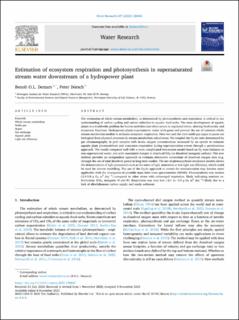Estimation of ecosystem respiration and photosynthesis in supersaturated stream water downstream of a hydropower plant
Journal article, Peer reviewed
Published version
Permanent lenke
https://hdl.handle.net/11250/3111846Utgivelsesdato
2023Metadata
Vis full innførselSamlinger
- Publikasjoner fra Cristin - NIVA [2149]
- Scientific publications [1172]
Sammendrag
The estimation of whole stream metabolism, as determined by photosynthesis and respiration, is critical to our understanding of carbon cycling and carbon subsidies to aquatic food-webs. The mass development of aquatic plants is a worldwide problem for human activities and often occurs in regulated rivers, altering biodiversity and ecosystem functions. Hydropower plants supersaturate water with gases and prevent the use of common whole stream metabolism models to estimate ecosystem respiration. Here we used the inert noble gas argon to parse out biological from physical processes in stream metabolism calculations. We coupled the O2:Ar ratio determined by gas chromatography in grab samples with in-situ oxygen concentrations measured by an optode to estimate aquatic plant photosynthesis and ecosystem respiration during supersaturation events through a parsimonious approach. The results compared well with a more complicated two-station model based on O2 mass balances in non-supersatured water, and with associated changes in dissolved CO2 (or dissolved inorganic carbon). This new method provides an independent approach to evaluate alternative corrections of dissolved oxygen data (e.g. through the use of total dissolved gases) in long term studies. The use of photosynthesis-irradiance models allows the determination of light parameters such as the onset of light saturation or low light use efficiency, which could be used for inverse modelling. The use of the O2:Ar approach to correct for oversaturation may become more applicable with the emergence of portable mass inlet mass spectrometers (MIMS). Photosynthesis was modest (2.9-5.8 g O2 m2 day−1) compared to other rivers with submerged vegetation, likely indicating nutrient co-limitations (CO2, inorganic N and P). Respiration was very low (-2.1 to -3.9 g O2 m2 day−1) likely due to a lack of allochthonous carbon supply and sandy sediment.

